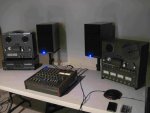Herm
Well-known member
As a few of you that may know me from the past I used to have a small collection of tascam gear. And after moving 6 years ago and finding out that it was crazy having all of it and hauling it from one house to the next I decided to sell it all so that if something happen to me my wife would not have to deal with it someday.
So saturday a nice young man came over and got the last of it. Here is a pic of the last of my recording equipment that I kept for my own use. After thinking long and hard on which recorder and mixer to keep it came down to this one. I know some of you will think im nuts for chossing this set up but it is the one I love the best and takes me back to a simpler time and found memeries of my recording and playing days in the 80,s.
So saturday a nice young man came over and got the last of it. Here is a pic of the last of my recording equipment that I kept for my own use. After thinking long and hard on which recorder and mixer to keep it came down to this one. I know some of you will think im nuts for chossing this set up but it is the one I love the best and takes me back to a simpler time and found memeries of my recording and playing days in the 80,s.




